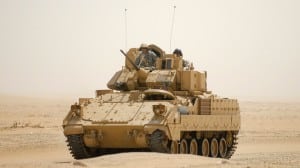The Army’s rapid technologies office has awarded BAE Systems a $32.2 million deal to integrate hybrid electric drives (HEDs) on test vehicles, as the service looks to prove out new electrification technologies for its combat vehicle fleet.
Under the two-year deal, announced Thursday, BAE Systems is tasked with retrofitting two of its Bradley fighting vehicles with HEDs, which will then undergo field assessments.

Photo: BAE Systems
“By rapidly prototyping HEDs on a small scale, we can jump-start advanced electrification and hybridization of Army platforms, and encourage our industry partners to invest in these products to meet Army standards,” Lt. Gen. Neil Thurgood, director of the Army’s Rapid Capabilities and Critical Technologies Office, said in a statement.
BAE Systems said it’s working with QinetiQ on the project, which will provide the electric cross drive transmission for the HED, with work to begin this summer.
“Integrating a Hybrid Electric Drive system into combat vehicles vastly increases on-board power and provides a significant increase in mobility, lethality options, and range, all of which enable overmatching operational capabilities,” Scott Davis, vice president of BAE Systems’ ground vehicles product line, said in a statement. “BAE Systems has invested and collaborated with industry for more than 40 years to advance HED technology and develop vehicle architectures and demonstrators. A systems approach to vehicle electrification enables break-through capabilities in the current and future platforms our warfighters need to maintain battlefield superiority.”
The prototype effort is part of the Army’s push to explore the use of vehicle electrification technologies, burgeoning in the commercial sector, as a means to “significantly reduce Army vehicle costs related to maintenance and fuel consumption, increase reliability, and improve performance, with no added size, weight and power (SWaP) demands.”
The Army said the HED to be integrated on the Bradleys consists of an upgraded transmission with an electric drive motor and lithium ion batteries.
“HEDs add a high-voltage generator that turns engine power into electricity for greater mobility and for operating additional equipment, both of which increase combat effectiveness,” Mike Foster, director of RCCTO’s Rapid Acquisition Prototyping Project Office, said in a statement. “It also offers the ability, because of its electric powertrain, to conduct silent overwatch missions and silent mobility.”